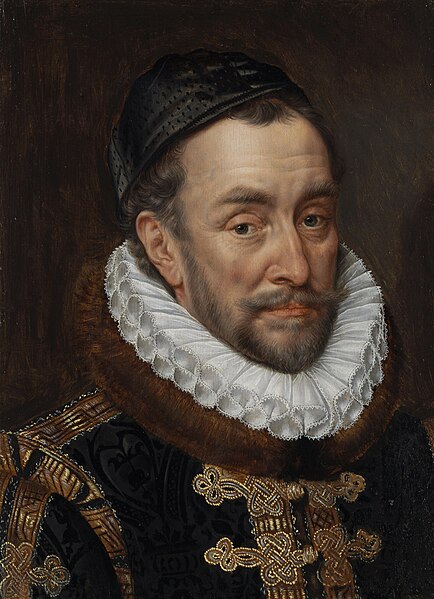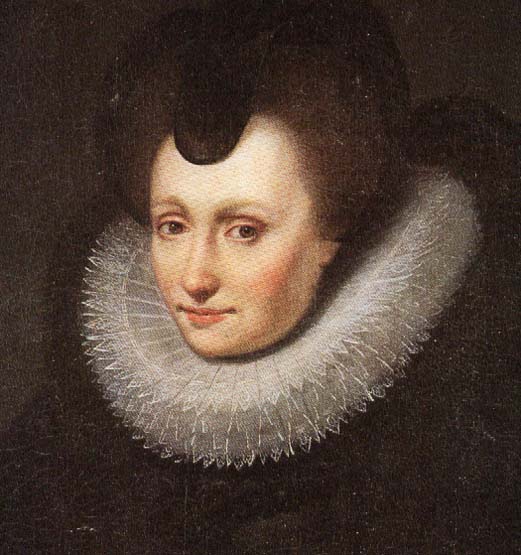 |
| William the Silent |
The Apologia
In January
1580 William visited Breda for the last time with Archduke Matthias as his
guest; they were greeted with a fireworks display in William’s honour. William
was conducting a two month tour of the north; Amsterdam had finally opened
their doors to the Prince of Orange, having finally thrown off their allegiance
to Spain. Den Haag welcomed him, as did Delft where Fulk Greville found him sat amongst the burghers,
all dressed in ‘mean’ clothing.
John of
Nassau accompanied his brother on his tour, during which William attempted to
dampen down anti-Catholic antagonism. Parma’s military ambitions were slowed
down as supplies from Spain were not forthcoming.
In March
1580 Philip issued a royal ban of outlawry against William, the ban, which
called William ‘an enemy of the human
race’, was an invitation to
murder. Indeed Philip promised a reward of 25,000 crowns[i] to any man who would
succeed in killing William. Parma did not believe that inviting assassins to
kill William would do anything but draw his people closer to him. But it did
mean that Charlotte spent a lot of time worrying about gifts of food that came
from well-wishers. William was especially fond of local dishes such as eel pie.
 |
| Philip Marnix |
The death of
both his wife and his and William’s mother[ii] precipitated John’s
return to Dillenburg in the summer of 1580; Juliana left 168 grandchildren to
mourn her along with her surviving children. During the following winter
William was frequently unwell and Charlotte nursed a recalcitrant patient, who
frequently refused to take his prescribed medications.
William was
well enough on 13th December 1580 to present his Apologia in reply to the decree
outlawing him to the Estates. It was an outstanding piece of anti-Spanish
propaganda;
‘The brightness of the fires
wherein they have tormented so many poor Christians, was never delightful nor
pleasant to mine eyes, as it has rejoyc’d the sight of the Duke of Alba and the
Spaniards.’[iii]
The Apologia was written from William’s
notes by Philip Marnix, the Lord of St-Aldegonde, he and his brother were long-time supporters of William’s.
This brilliant tract, distributed among all the courts of Europe during early
1581, vindicated William’s rebellion against his sovereign lord and denounced
Philip’s tyranny. In response Philip wrote an Antiapologia, but very few people took the time to read it.
Anjou
 |
| Henri, Duc d'Anjou |
In February
1582 the Duke of Anjou made a triumphal entry into Antwerp where he was named
Duke of Brabant by William. William believed that it was possible to make the
arrogant Anjou, if not popular, then at least acceptable. His household was to
be reorganised, replacing French dignitaries with Flemish nobles, and with
William as Anjou’s Grand Chamberlain.
Anjou’s
authority was rejected by a number of the provinces for reasons of religion or
local interest. This, the greatest of William’s faux pas, increased the
disintegration of the provinces. One English observer wrote;
‘There is great disorder
here for there is no man that will obey.’[iv]
Even so
French recruits, encouraged by Anjou’s new standing in the Netherlands, were
amassing on the borders, making it seem possible that the rebels would be able
to counter Parma’s spring offensive.
.jpg) |
| Juan de Jauregui attempts to kill William |
On Anjou’s
birthday 18th March 1582, when great festivities were planned, an attempt
was made on William’s life. A Portuguese merchant named Gaspar de Añastro
organised for one of his clerks to kill William. Juan de
Jáuregui was conned into believing that after
the attack he would become invisible and easily escape.
When William came out of his dining-room, Jáuregui
fired a pistol at his head. Although the pistol was badly designed and
malfunctioned, one bullet pierced the neck below the right ear and passed out
at the left jaw-bone, but William ultimately recovered. Jáuregui was pierced on
the spot by a knight’s sword and was then killed by the halberdiers of
William’s bodyguard.
After the Assassination
William was
nursed back to health by Charlotte and his sister Mary. On 5th May
1582 Charlotte died and William was grief stricken. It has been claimed that
Charlotte wore herself out looking after William after the attack in March. Charlotte
attended a service of thanksgiving for the saving of William’s life; eleven
days later she was dead, the doctors diagnosed double pleurisy.
 |
| Satirical painting showing Anjou's failed attempt to milk the Dutch |
Anjou was not satisfied with the limited powers granted
by the Estates General and decided on a coup d’état; he decided start by seizing Antwerp
by force. The citizens were warned, after the quarterly check of foreigners in
the town found an additional 3,000 French lodging in the suburbs. Anjou had
expected the Catholic majority to side with him but he and his troops were
ambushed as they entered the city on 18th January 1583[v]. Most of Anjou's men were killed, and among
the corpses were found Anjou’s friends;
‘Two hundred gentlemen or what you will dressed in rich brocade.’[vi]
An unrepentant Anjou was reprimanded by both his mother
Catherine de’ Medici and Queen Elizabeth.
 |
| Louise de Coligny |
After this attack Anjou’s position swiftly became
untenable; he eventually left the country in June. His departure discredited
William, who continued to maintain his support for Anjou, politically isolating
himself. He pointed out that throwing over Anjou meant throwing away the troops
that came with him, something the rebels could ill afford to do.
On 24th
April 1583 William married Louise de Coligny, the daughter of Admiral Coligny. Louise was widowed
the same night she lost her father. Louise took charge of William’s household,
looking after the girls still at home. The marriage was unpopular at home as
the Dutch equated the Huguenot Louise with the Catholic Anjou and all things
French. William became a father again on 29th January 1584 when Frederick Henry was born.
On 16th
July 1583 Anjou’s governor of Dunkirk surrendered the town to the Duke of
Parma, further exacerbating Dutch fury with the French and making William’s
task even more difficult. Parma now had an outlet to the sea and thence to
Spain.
Death And After
 |
| Balthasar Gerard |
On 10th
July William was assassinated by Balthasar Gérard[vii], who had introduced himself to
William as a French nobleman. Gérard hoped to collect Philip’s munificent reward.
As proof of his good faith Gérard[viii] gave William the seal of the Governor of Luxembourg Peter Ernst I von
Mansfeld-Vorderort. The seal would allow forgeries of Mansfelt’s
messages to be made. William sent Gérard back to France to pass the seal on to
his French allies.
Upon his
return from France, having
bought two wheel-lock pistols, Gerard made an appointment to see William who was dining at
the Prinsenhof with a guest Rombertus van Uylenburgh. After William left the dining room and walked
down-stairs, Van Uylenburgh heard Gérard shoot William in the chest at close
range. Gérard fled immediately.
 |
| Adolf von Neuenahr |
Traditionally, members of the
Nassau family were buried in Breda, but
as that city was under Spanish control, he was buried in the New
Church in Delft. William’s eldest
daughter Marie wrote;
‘When I recollect that we are now all orphans and
do not know where or whither to turn, my heart is so full of sorrow that I
hardly know what I do.’[ix]
Gérard was caught before he could
escape Delft, and was imprisoned and tortured before his trial on 13th
July, where he was sentenced to an execution brutal even by the standards of
that time. The magistrates decreed that Gérard’s right hand should be burned,
that his flesh be torn from his bones with pincers in six different places,
that he be quartered, that his heart should be torn out and his head should be
cut off. His family were rewarded by Philip with not only the reward but three estates which Philip was later to offer to Philip William provided he continue to pay a fixed
portion of the rents to the family of his father's murderer; he scornfully rejected the offer.
After some
delay, the States-General appointed William’s nephew Adolf von Neuenahr as stadtholder of his former
provinces in William's stead. Philip William inherited his father’s
principality, but he had no children and on his death in 1618 Maurice took his brother’s
place as Prince of Orange. Maurice was a life-long bachelor and in 1625 when he
died the principality passed to William’s youngest son Frederick William whose
grandson was to inherit the throne of England.
Overall the
revolt took eighty years to wear down Spanish opposition and it was not until
1648 that the Peace of Münster was signed by both sides,
acknowledging the right of the Dutch Republic to exist, free of Spanish rule.
Bibliography
The Age of
Religious Wars – Richard S Dunn, Weidenfeld & Nicholson 1971
The Revolt
of the Netherlands – Pieter Geyl, Cassell History 1988
The Spanish
Inquisition – Henry Kamen, Phoenix 1998
Philip of
Spain – Henry Kamen, Yale University Press 1998
The Spanish
Armada – Colin Martin and Geoffrey Parker, Guild Publishing 1988
The Grand
Strategy of Philip II – Geoffrey Parker, Yale University Press 1998
Elizabeth –
Anne Somerset, Phoenix Giant 1999
William the
Silent – CV Wedgewood, Readers Union Ltd 1945
[i]
In 2014
the relative: historic standard of living
value of that income or wealth is £7,211,000.00 economic status value of that income or wealth is £237,100,000.00 economic power value of that income or wealth is £2,343,000,000.00 www.measuringworth.com
[ii]
Juliana died on 18th June 1580
[iii]
The Spanish Inquisition - Kamen
[iv]
Philip of Spain - Kamen
[v]
Known as the French Fury
[vi]
William the Silent - Wedgewood
[viii]
A soldier formerly serving Count Mansfeld
[ix]
William the Silent - Wedgewood
No comments:
Post a Comment
Note: only a member of this blog may post a comment.